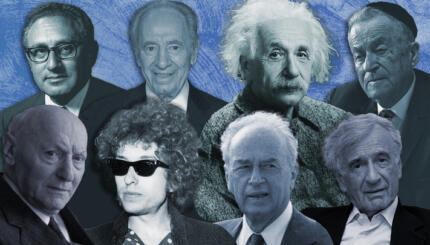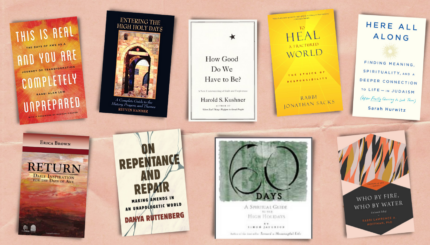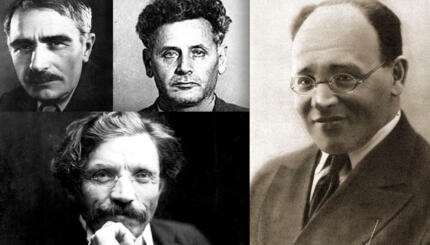The Hebrew Bible, that repository of stories about the full range of human behavior–from the cowardly to the courageous, the noble and the base–includes its share of humor. To get some appreciation of the humor dotting its way through the Hebrew Bible, think of how it differs sharply the Christian Testaments.
As a character from a Bernard Malamud story once put it, “Jesus is a humorless guy.” If the stories in the Hebrew Bible are about people, complete with a capacity for laughter, the “greatest story ever told” is about a demi-God. No irony, no ambivalence, and certainly no jokes need apply.
By contrast, the Jewish humor we recognize instantly happens when a wag is told that we are the Chosen People and who wonders–out loud and after morning prayers–if, perhaps next time, God might choose somebody else. Between rabbinic solemnity and life’s grittier edges lies Sholem Aleichem’s Tevye, a man who confides that “with God’s help I starved three times a day.”
Humor of Oppression
Saul Bellow once pointed out that “oppressed people tend to be witty.” True enough–for the Irish, for blacks in America, and most certainly for the Jews. Humor is what the powerless have, and what they rely on. If Jewish humor is often a shield meant to deflect Gentile fists, it can also be a weapon wielded from an oblique angle. But whether it be shield, weapon, or some combination of the two (a shweapon?) humor has been an essential ingredient in Jewish survival.

Help us keep Jewish knowledge accessible to millions of people around the world.
Your donation to My Jewish Learning fuels endless journeys of Jewish discovery. With your help, My Jewish Learning can continue to provide nonstop opportunities for learning, connection and growth.
From the destruction of the Temple onward, Jewish humor has often been described as “bittersweet,” a laughter filtered through tears. It produced a lively retinue of comic types–the residents of Chelm, the city of fools of Yiddish folktales, the schnorrer (beggar), the nudnick (pest), and my special favorite, the schlemiel, a character who is the architect of his misfortune and as such, easily transported to America. He shows up in everything from Charlie Chaplin’s poignantly loveable little tramp to Woody Allen’s neurotic Upper-West-Side New Yorkers.
If 19th-century American humor was dominated by ring-tailed roarers who boasted that they have the fastest horse, the prettiest sister, and the truest rifle in all of Kentuck’–and furthermore, that they can beat up any man in the house–20th-century humor was filled to the brim with people who insisted that they were smaller, weaker, and more sensitive than anybody in the living room.
Granted, there are wide streaks of comic self-abnegation in James Thurber’s Walter Mitty and Charles Schultz’s Charlie Brown, but taken as a whole, the humor that washed up on American shores along with the waves of Jewish immigrants soon became American humor. Jewish comics simply had a better feel for shtick, for the highly verbal, machine-gun delivery known as spritz–one thinks of Sid Caesar, Lenny Bruce, Don Rickles–and perhaps most of all, for seeing the world through the perspective of an outsider.
The eventual dominance of Jewish humor did not come easily or without cost. On the rough-and-tumble vaudeville stage, ethnic types (stage blacks, Irishmen, and Jews) told self-hating jokes to make a simple point–namely, that, in America, there was no room for shuffling darkies, drunken Irishmen, or kikey Jews. As the metaphor of the melting pot would have it, ethnicity should be willingly sacrificed on behalf of becoming a true-blue American. For Jews this meant, among other things, shedding their Yiddish accents.
Entertainers were a notable exception, as Yiddish soon became Hollywood’s lingua franca and the flavoring, however it may have been diluted, that one recognizes in comics from Myron Cohen to Jackie Mason. A Yiddish accent and, even more important, the very rhythm of their speech patterns marked them as Jews, despite the fact that the words tumbling out of their mouths were English.
Can Assimilated Jews Be Funny?
As the 20th century neared its end, the mines of Borsht Belt, that veritable breeding ground for Jewish-American comics, reached a point of exhaustion. Most Jewish Americans could not remember hearing Yiddish spoken around the house either by a grandfather or an uncle. Nobody shouted “Kim bald heim” when it was time to come home for dinner or whispered “Sha… sha” when you were making too much racket.
The world in which activities were sharply divided into the encouraged (studying, eating your vegetables, and being “nice”) and the forbidden (climbing trees, playing baseball, and running around like a vilde chaiye, a wild animal) has long ago been replaced by young Jewish adults who play tennis at the country club, go on Colorado ski trips, and think of their tanned athletic bodies without noticeable guilt.
What could Jewish humor of the old-fashioned sort mean to people who have become so comfortable in America that it is hard for them to remember a time, an ethos, when a Jew’s joy was immediately followed by trembling? Which brings me, at long last, to the point of my title: Will assimilation’s successes be the death knell for Jewish-American humor? I think not.
Why so? Because I count myself among those who feel we are enjoined to “Choose life,” I’ve long turned down invitations to any number of burials–for the American novel during the late l960s, the formalist poem a decade later, and for literature itself during the theory-mad l980s. I suspect that the coffin of Jewish-American humor will be equally empty.
True enough, 20- and 30-somethings will want a hipper, edgier Jewish-American humor (how could they not?), and they are finding it in things like Adam Sandler’s “ Song”–a send-up of “I have a little dreidl” Hanukkah ditties as well as a frank, unembarrassed look at what assimilation means in terms of half- and three-quarter Jewish Americans–and in Jon Stewart’s The Daily Show, a savagely satiric, and I would argue, outsider’s view of American politics.
In addition, the comix-as-art crowd have a Jewish-American champion in Ben Katchor. Unlike most of his contemporaries, Katchor grew up in a Yiddish-speaking home and this fact flavors such long-running strips as The Jew of New York and Julius Knipl, Real Estate Photographer. Those “in the know” know that a “knipl” is money put aside for a rainy day, which in the case of Katchor’s real estate photographer is part of the joke about his history of economic reversals. He is yet another form that the schlemiel can take, just as HBO’s Curb Your Enthusiasm makes it clear, week after week, that an annoyingly funny millionaire curmudgeon can also be a schlemiel.
Three Glimpses of the Future
I conclude with three Jewish-American fictionists: Jonathan Safran Foer, Gerald Shapiro, and, Steve Stern. There are, of course, dozens of other writers who have livened up contemporary Jewish-American fiction; moreover, what I say about the ones I’ve chosen is limited to the prospects for Jewish-American humor in this century.
I begin, then, with Jonathan Safron Foer’s ambitious first novel, Everything is Illuminated, a work in which dialect humor happens not from its Jewish protagonist but from his Ukrainian guide. The fractured English is hilarious in its own right but also part of the sheer excess at the heart of the various “histories” Safron Foer learns about.
By all the laws of literary logic Gerald Shapiro’s three collections of short fiction should not exist. Writing about delis and Jewish guilt is not only quixotic but downright doomed. Still, Shapiro brushes off the old, by-now-stale material and makes it sing. As Kafka, and later Philip Roth, knew full well, Jewish guilt is funny.
Here is how one of Shapiro’s protagonists describes his conflicted feelings when visiting day at camp was over and his father drove out of sight: “as Ira watched his father disappear into the dust of the gravel road, he felt free again, as if he’d just been pulled out of a lake full of glue… until the guilt started nibbling away at his innards again, a sensation that made him imagine that some angry little carnivore that was trapped inside his stomach was eating its way out.”
Steve Stern combines many of the threads I’ve been talking about in The Wedding Jester, a story set in a crumbling Catskill hotel where an old comic turns up as a dybbuk (demon) who takes over the body of the bride. Moldy jokes, many of them x-rated, pour out of the bride’s mouth, and one of the book’s wonders (there are many) is that the jokes are funnier than they probably should be.
Many have argued that humor is the major export of the Jews. With a few caveats, this is probably true, just as it is certainly true that Jewish-American humor will not only continue but also find new ways to thrive. Smart-alecky Jewish kids, full of moxie, used to make their way to vaudeville stages where they sang, danced, and often got a shpritz of seltzer vasser up their pants. Nowadays, bright, restless kids create websites and put together shows (imagine a Wayne’s World) for public-access TV. No doubt lots of this is self-indulgent junk, but thus was it ever. As the Curies discovered, it takes sifting through a mountain of pitchblende to find an ounce of uranium. With Jewish-American humor, then and now, it’s pretty much the same thing.


